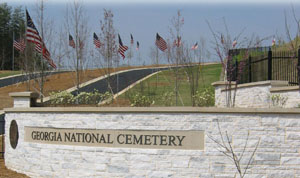Georgia National Cemetery
2025 Mount Carmel Church Lane
Canton, GA 30114
Phone: (866) 236-8159
or (770) 479-9300
Fax: (770) 479-9311
|
Office Hours:
Monday thru Friday 8:00 a.m. to 4:30 p.m.
Closed federal holidays.
Visitation Hours:
Open daily from sunrise to sunset.
|

|
Burial Space: This cemetery has space available to accommodate casketed and cremated remains.
Acreage: 774.89
Number of Interments
Thru Fiscal Year 2008: 2,154
General Information Kiosk on Site? Yes
Floral/Ground Regulations
|
Directions from nearest airport:
Directions from I-75: Take exit 290 (Highway 20) toward Canton (east). Travel 10 miles, turn left into cemetery entrance located near Knox Bridge.
Directions from I-575: Take exit 14 toward Canton, at the 4th light (Butterworth Rd) turn left, go to the 2nd light (Hwy 20) turn left, travel approximately three miles, cross the Knox Bridge and the cemetery entrance is on the right. |
GENERAL INFORMATION
The Georgia National Cemetery opened for burials on April 24, 2006.
The new 775-acre national cemetery in western Cherokee County, Ga., will serve veterans for the next 50 years.
The property on which the cemetery rests was donated by Scott Hudgens, the late Atlanta World War II veteran, land developer and philanthropist. The site lies midway between Cartersville and Canton, near the Etowah River, offering views of the Blue Ridge Mountains and Lake Allatoona.
J. M. Wilkerson Construction Company, Inc., of Marietta, Ga., was awarded the construction contract in December 2004. In addition to an entrance area, an information center, administration and maintenance building, public restrooms, flag plaza, shelters for committal services, the project includes a total of 33,000 full-casket gravesites, 3,000 in-ground sites for cremation remains and 3,000 columbaria niches for cremation remains.
Burial arrangements will be made after death, as with all national cemeteries. VA does not reserve grave space. Veterans or spouses wishing to be buried in national cemeteries should have the veteran’s military separation papers available to establish eligibility, which requires an other-than-dishonorable discharge. Dependent children may also be buried.
back to top
HISTORICAL INFORMATION
Georgia National Cemetery is the third national cemetery in Georgia and the 123rd in the national cemetery system. A private citizen donated the 775-acre site to the National Cemetery Administration in 2001. At maximum capacity, 330 acres of the site will be developed for burials; the remainder of the site is too steep to be used for interments. Historically, the site was used for logging purposes and as a hunting ground for local residents.
Georgia National Cemetery is located near the site of the Etowah burial mounds, created by American Indians of the Mississippian culture between AD 1000-1550. This site is one of the largest American Indian burial mounds in North America. Archaeological investigations have been conducted on Etowah mounds for over one hundred years.
Georgia National Cemetery opened for burials in 2006, and was formally dedicated on June 4 of that year.
back to top
NOTABLE PERSONS
Under Development
back to top
FLORAL/GROUNDS REGULATIONS
Floral arrangements accompanying the casket or urn at the time of burial will be placed as follows, a maximum of six will be placed on the grave and the remainder will be placed at a central location.
Fresh cut flowers may be placed on graves at any time of the year. They will be removed when they become unsightly or when it becomes necessary to facilitate cemetery operations such as mowing. Floral cones are available near each burial section at the water station.
Artificial flowers will be permitted only between Nov. 10 and March 1. Potted plants will be permitted on graves only for a period extending 10 days before through 10 days after Easter Sunday, Memorial Day and Veterans Day.
Christmas wreaths, grave blankets and other seasonal adornments may be placed on graves from Dec. 15 through Jan. 10. They may not be secured to headstones or markers.
Permanent plantings, statues, vigil lights, breakable objects and similar items are not permitted on the graves. The Department of Veterans Affairs does not permit adornments that are considered offensive, inconsistent with the dignity of the cemetery or considered hazardous to cemetery personnel. For example, items incorporating beads or wires may become entangled in mowers or other equipment and cause injury.
Permanent items removed from graves will be placed in an inconspicuous holding area for one month prior to disposal. Decorative items removed from graves remain the property of the donor but are under the custodianship of the cemetery. If not retrieved by the donor, they are then governed by the rules for disposal of federal property.
COLUMBARIUM FLORAL REGULATIONS
Fresh cut flowers may be placed in the floral cones provided. The cones are to be placed in the gravel area surrounding the columbarium. Flowers will be removed when they become withered, faded or otherwise unsightly.
Artificial flowers are permitted during the period of Nov. 10 through March 1.
Potted plants, permanent planting, statues and upright stands are not permitted. At no time will flowers or other objects to be placed on the columbarium top or attached to the niche covers
back to top
|


